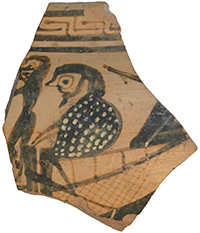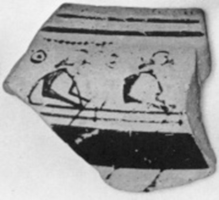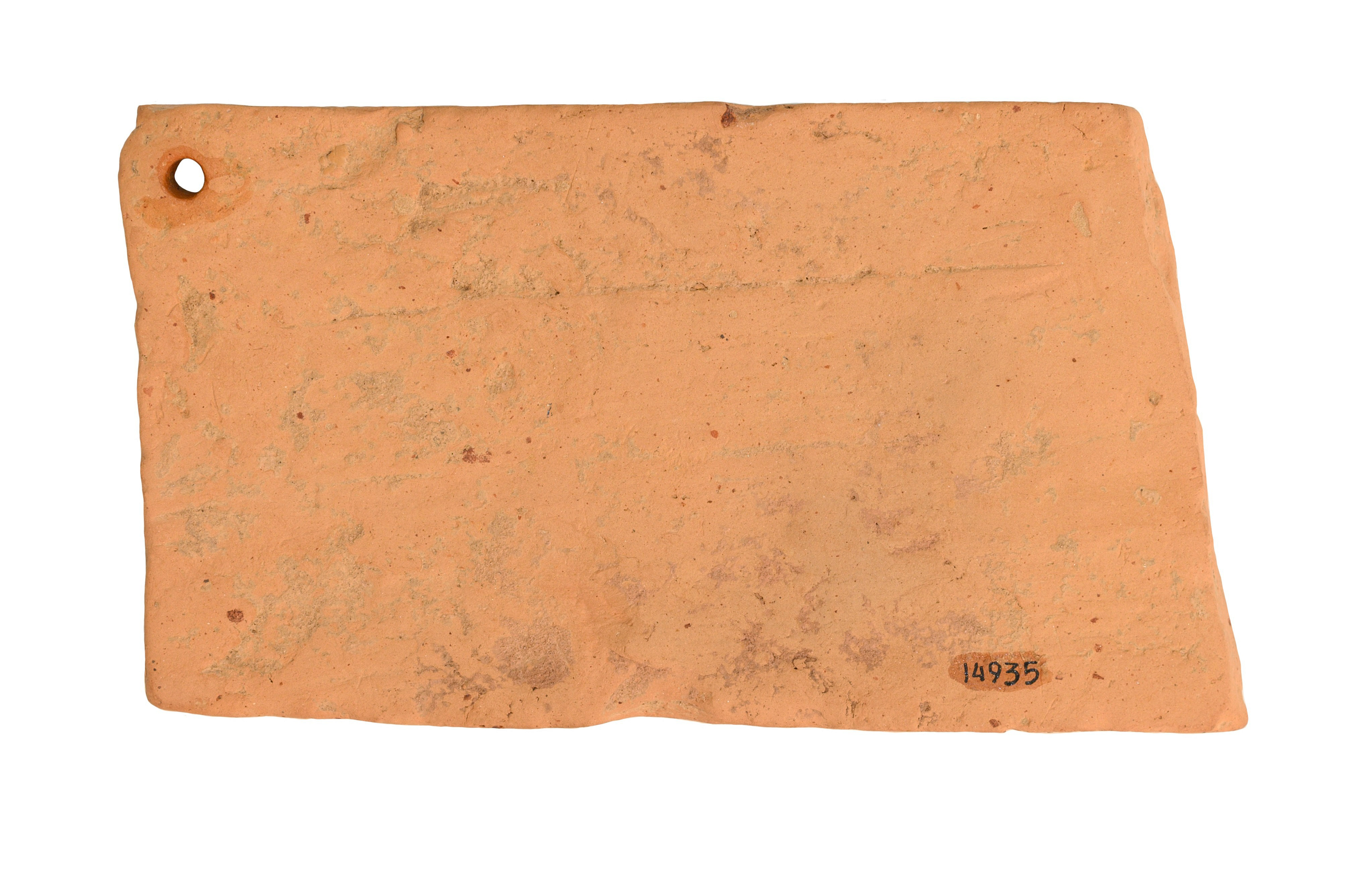Single-levelled ship to the left, with the after half of the vessel preserved. Flat hull of medium thickness curving gently towards a low sternpost ending in a square extremity pointing upwards. The aftercastle consists of a low cross-hatched bulwark that hugs the curvature of the sternpost and extends past it into an incurving horn. Above it is a rail joined to the end of the sternpost. The helmsman is depicted sitting behind the rail which is at shoulder level, with the lower part of his torso hidden behind the latticed bulwark. He handles an enormous steering oar with a rectangular oar blade. There are two horizontal lines running parallel above the hull, with the lower one supported by five regularly spaced vertical stanchions. Six oars with triangular oar blades are attached to the upper horizontal by pairs of short oblique lines which represent the leather thongs or straps that fastened the oars to their tholepins. The oars are placed midway between two stanchions and have no rowers, nor are they associated to the warriors which are spaced between them. Five diminutive warriors face left, equipped with crested helmets, round shields, and two spears.
Single-levelled galley
A172
Early Proto-Attic, first years of the 7th century
Sounion, sanctuary of Athena
H: 7 cm; L: 12 cm
Half of a painted terracotta plaque attributed to the Analatos painter. Suspension hole in the upper corner
Athens National Museum 14935
Basch 1987: 202-203, no. 421a-b; Boardman 1954: 198, Sunium no. 1; Burgess 2001: 37-38; Cook 1934-1935: 173, pl. 40b; Kirk 1949: 119-20, fig. 7; Morrison-Williams 1968: 73-74, Arch. 2, pl. 8b; Neumann 1979: 14, pl 11b; Wedde 1996: 135, fig. 24; 1999a: 511-12, fig. 8
This vessel has been variously interpreted as either decked or open hulled. The controversy centers around the pair of horizontal lines above the hull which some read as a deck. Such a reading makes for impossibly stunted warriors, with the lower half of their bodies sunk into the deck. There are however sufficient indications that the double line should instead be read as a raised railing. The most important detail in this regard is that the lower part of the shields does not touch the upper horizontal directly, with the two separated instead by a triangle shaped bloc of paint which must represent the waists and the upper part of the thighs and legs of the warriors as they sit, with the remained of their legs disappearing behind the rail. The rowers on the Toronto bowl (A169) are a good example of this, with their legs disappearing behind a similar reserved line which may simply indicate the thickness of the railing. The placement of the oars with their straps on top of the upper line provides further indication that this is a vertical element rather than a deck. The space between the railing and the hull supported by the stanchions should still be read as open, with the painted opting not to show the continuation of the warriors' bodies to prevent cluttering. Another Proto-Attic fragment with a similar depiction actually shows the lower part of the warriors' shields disappearing behind the hull, again suggesting that the figures are depicted as seated.
Painted and relief votive plaques form the most important group of offering from both sanctuaries at Sounion, of which thirty were discovered at the sanctuary of Athena (Polychroniadis 2014: 4). Although the subject matter of this plaque is unassuming at first glance, there are several indications regarding its narrative and mythological nature. Unlike the uniformity of the hoplites, the helmsman clearly stands out both in terms of detailing and the fact he is painted on a much larger scale, highlighting his importance. Taking the votive context into account, the depiction recalls the Homeric reference to Sounion and the burial of the legendary Phrontis (helmsman of Agammemnon) on the Cape (Od. 3.278-285). The brief allusion to the story indicates that it was known in pre-Homeric myth, while it is furthermore implied in the passage that there was already a cult practiced there before the burial of Phrontis. Since a hero cult to Phrontis is independently suspected on archaeological grounds at the sanctuary, it is therefore quite likely that the plaque references this story.
Basch, L. 1987. Le musée imaginaire de la marine antique. Athens: Institut Hellénique pour la preservation de la tradition nautique.
Boardman, J. 1954. ‘Painted votive plaques and an early inscription from Aegina’, BSA 49: 183–201.
Burgess, J. S. 2001. The Tradition of the Trojan War in Homer and the Epic Cycle. London: The Johns Hopkins University Press.
Cook, J. M. 1934-1935. “Protoattic Pottery.” BSA 35: 165-219.
Kirk, G.S. 1949. “Ships on Geometric Vases.” BSA 44: 93-153, pls. 38-40.
Morrison, J.S. and R.T. Williams. 1968. Greek Oared Ships: 900-322 B.C. Cambridge: Cambridge University Press.
Neumann, G. 1979. Probleme des griechischen Weihreliefs. Tübingen: E. Wasmuth.
Wedde, M. 1996. “From Classification to Narrative: The contribution of Iconography towards writing a History of Early Aegean Shipbuilding,” MHR 11.2: 117-164.
―――. 1999a. “Decked Vessels in Early Greek Ship Architecture,” in H.E. Tzalas (ed.) Tropis V: 5th International Symposium on Ship Construction in Antiquity. Nauplia, 26, 27, 28 August 1993. (Hellenic Institute for the Preservation of Nautical Tradition). Athens: Hellenic Institute for the Preservation of Nautical Tradition, pp. 505-526.








